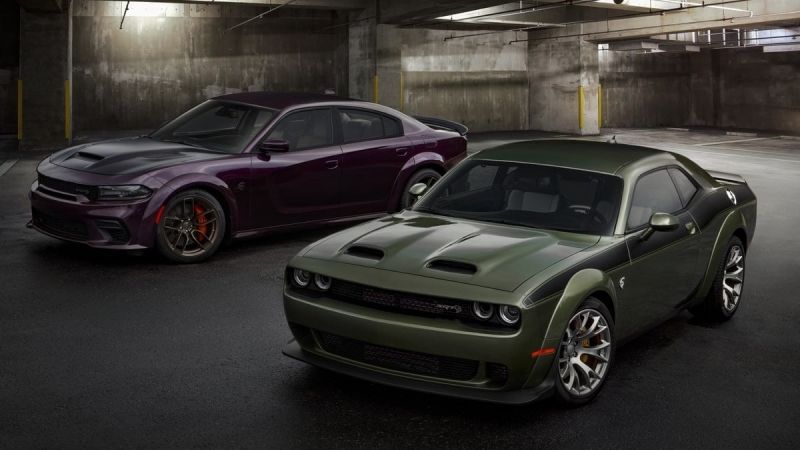I decided to check what Dodge Challenger owners do with their cars (aside from the obvious, stereotypical shenanigans) and stumbled upon a topic I feel isn't talked about enough. A member of the Challengertalk.com forum recently did an oil change on his Dodge Challenger and noticed fluctuations in the oil pressure that he isn't sure are normal. Here's what he says:
“So, this isn't something I monitor at all, but when I got this car, I thought it was neat that they gave you these gauges to see what else is going on with the car, I recently did an oil change, and I add the 6 quarts of the oil (5w20 syth). But the dipstick always shows it fills up to a little above 3 quarters without running it after the change, this time I dumped an extra... 2 ounces into it.
When I looked at the Oil pressure gauge, idle pressure goes to about... 31 to 25 if I sit long enough, if I'm city driving slowly, it always goes up to about 41 (that or 46-47, forgot at the time of writing this), keeping it under 2k RPM, now since I haven't looked into this with other performance cars and whichever, I'm wondering if I got an issue and I need to drain some oil.
When I give it the guts on the highway to overtake for example, at about 4-5k RPM, the gauge skyrockets to 98-100 PSI, is this normal for the car? Or are the seals and gaskets going to go kaboom? FYI I have the V-6 auto.”
Before anyone starts with the “you should have gotten a V-8" jokes, the Pentastar is, actually, a solid unit, if a bit underwhelming compared to the HEMI variants. For those who love the company's signature pushrod units, we already know that Dodge is bringing back the V-8. While this could hurt the popularity of Stellantis’ Hurricane inline-six engine, it would make up for the coldly received Charger Daytona EV.
Understanding oil pressure fluctuations
Some mechanics will tell you that the oil pressure should be 10 psi for every 1,000 RPM. If your engine speed is 2,500 RPM, the oil pressure should be 25 psi. However, this explanation does not apply to all engines. This Challenger has the 3.6-liter Pentastar V-6, which means it has a dual-stage oil pump. This is essentially two oil pumps into one, with one stage being responsible for low flow rates and the other for high-flow rates.
Dual-stage pumps are more efficient at high-flow rates, while the single-stage pump is best-suited for low to moderate flow rates and requires more power to work. In the case of the Pentastar V-6 engine, the maximum oil pressure is limited to 145 psi through the pressure relief valve. Engine oil pressure is typically much higher when the engine is cold. Once the powertrain reaches operating temperature, the oil pump switches to the lower stage.
Many owners of the 3.6-liter Pentastar V-6 engine claim that, on cold starts, their engine il pressure is between 55 and 80 psi on startups, depending on outside conditions. Once they get up to operating temperature, most owners report around 20-25 psi of oil pressure, while some claim as low as 14 psi.
The discussion is still fresh, so I could update later with more valid responses by other members. Some fellow Dodge owners have already chimed in with good explanations.
ShelbyRazorback says: “Is this a 3.6L Pentastar? If so, it's normal. The V-6 has a two-stage oil pump. There is a high and low pressure depending on RPM and temperature. I don't remember the spec, but the lowest it should be at idle is 18 - 20 psi, I think.”
A Guy says: "Welcome to Challenger talk. I see high 80s on a cold start and driving around town at idle at a light I see as low as 24. A little over or under shouldn't affect pressure. The Pentastar has an actual windage tray, so no oil frothing if slightly overfilled either."
Final thoughts
The owner does not report any warning lights related to the oil and frankly, two ounces is a negligible amount to think about overfilling. The 3.6-liter Pentastar takes 6.0 quarts of oil, according to the specifications. Some owners claim that the oil-pressure gauge is nothing more than a gimmick and doesn't read accurately, but until someone compares the reading to an “actual” oil-pressure reading, we won't know for sure.
If you have a similar experience or any insight, I would love to read your thoughts in the comment section below.
Dimitar Angelov's automotive interests made him an expert in a wide variety of vehicles. Japanese brands like Toyota are closest to his heart, although performance cars in general are his favorite segment, which is why he is constantly on the lookout for the best deals on the market. Dimitar Angelov's car passion and knack for the written word led him to complete a Master of Arts in Media and Communications, and classic car restoration. Dim is happy to get behind the wheel of any car and share his impressions. You can follow Dimitar on X, Linked-in, Instagram, and Facebook.
Image source: 2022 Dodge Challenger GT












